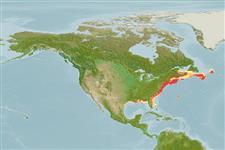>
Syngnathiformes (Pipefishes and seahorses) >
Syngnathidae (Pipefishes and seahorses) > Syngnathinae
Etymology: Syngnathus: Greek, syn, symphysis = grown together + Greek, gnathos = jaw (Ref. 45335).
Environment: milieu / climate zone / depth range / distribution range
Écologie
marin; eau douce; saumâtre démersal; amphidrome; profondeur 5 - 49 m (Ref. 126547). Subtropical; 50°N - 26°N
Western Atlantic: Gulf of St. Lawrence in Canada to northeastern Florida in USA; also in northwestern Gulf of Mexico.
Taille / Poids / Âge
Maturity: Lm ? range ? - ? cm
Max length : 33.0 cm TL mâle / non sexé; (Ref. 6330); common length : 17.0 cm TL mâle / non sexé; (Ref. 6330)
Inhabits seagrass beds in bays and estuaries, but also enters fresh water (Ref. 7251). Resident in estuaries during spring through fall, migrates into near shore continental shelf waters during winter. Found in waters of 4-17 °C. Ovoviviparous (Ref. 205). The male carries the eggs in a brood pouch which is found under the tail (Ref. 205).
Life cycle and mating behavior
Maturité | Reproduction | Frai | Œufs | Fécondité | Larves
Male carries the eggs in a brood pouch (Ref. 205).
Lazzari, M.A. and K.W. Able, 1990. Northern pipefish, Syngnathus fuscus, occurrences over the Mid-Atlantic Bight continental shelf: evidence of seasonal migration. Environ. Biol. Fishes 27(3):177-185. (Ref. 6330)
Statut dans la liste rouge de l'IUCN (Ref. 130435)
Menace pour l'homme
Harmless
Utilisations par l'homme
Plus d'informations
Taille/ÂgeCroissanceLongueur-poidsLongueur-longueurFréquences de longueursMorphométrieMorphologieLarvesDynamique des populations larvairesRecrutementAbondanceBRUVS
RéférencesAquacultureProfil d'aquacultureSouchesGénétiqueElectrophoresesHéritabilitéPathologiesTraitementNutrientsMass conversion
Outils
Articles particuliers
Télécharger en XML
Sources Internet
Estimates based on models
Preferred temperature (Ref.
123201): 0.5 - 20.4, mean 4.9 °C (based on 199 cells).
Phylogenetic diversity index (Ref.
82804): PD
50 = 0.5000 [Uniqueness, from 0.5 = low to 2.0 = high].
Bayesian length-weight: a=0.00028 (0.00012 - 0.00065), b=3.21 (3.03 - 3.39), in cm total length, based on LWR estimates for this Genus-body shape (Ref.
93245).
Niveau trophique (Ref.
69278): 3.2 ±0.0 se; based on diet studies.
Résilience (Ref.
120179): Haut, temps minimum de doublement de population inférieur à 15 mois (Preliminary K or Fecundity.).
Fishing Vulnerability (Ref.
59153): Low vulnerability (23 of 100).
